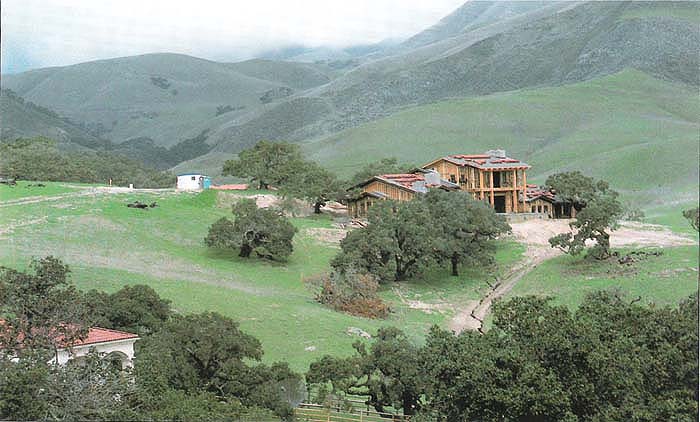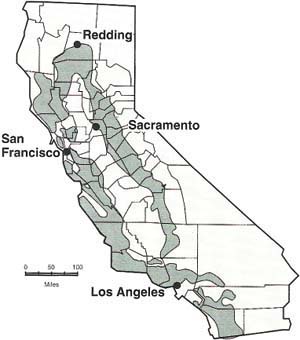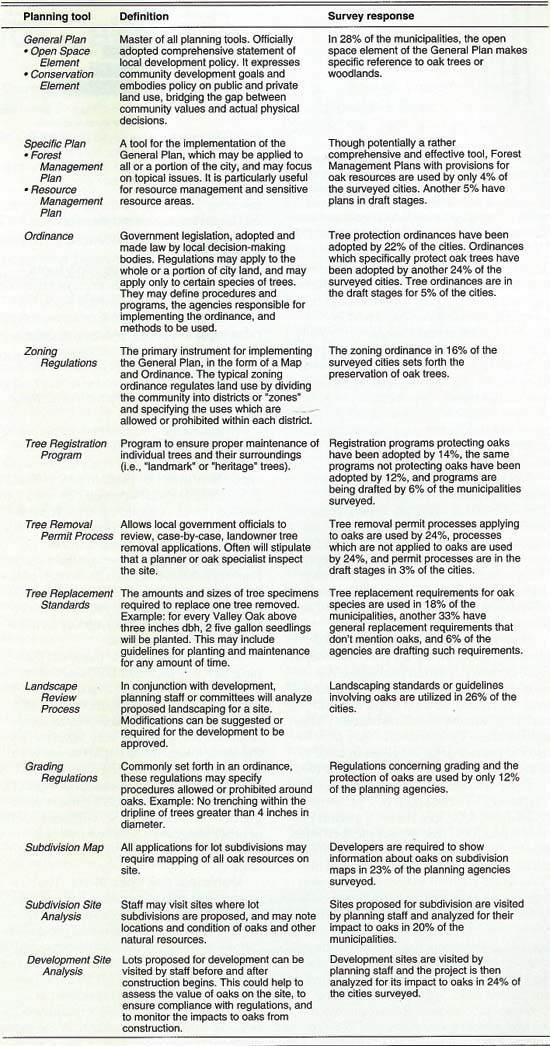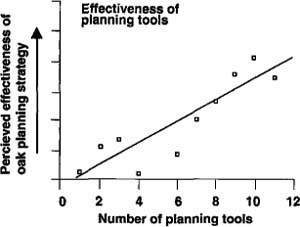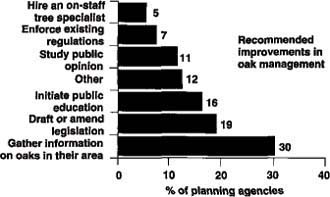All Issues
In California's municipalities, saving native oaks calls for planning
Publication Information
California Agriculture 46(2):20-22.
Published March 01, 1992
PDF | Citation | Permissions
Abstract
Regulations, incentives and educational programs, according to a new study, appear to be the most effective combination of strategies needed to maintain California's native oaks in municipalities.
Full text
To lose California's native oaks would be to lose a valuable part of the state's heritage and to compromise its natural resources and its economic and aesthetic values. California's native oaks are valuable because, singly and in stands, they (1) aid the cycling of soil nutrients (2) help prevent soil erosion, (3) protect water quality on watersheds (4) purify the air we breathe, (5) provide habitats for more than 300 species of vertebrate wildlife, (6) provide income from sale of hunting rights and wood products, (7) enhance property values and (8) attract tourists.
Fig. 1. Composite distribution of blue oak, valley oak, Engelmann oak, interior live oak, and coast live oak (Griffin and Critchfield, 1976) in which 305 municipalities were surveyed.
Nevertheless, native oak numbers have diminished in California since World War II, and only in the past decade has opposition to their destruction developed. In response to concerns about managing and maintaining the state's oak resources, in 1986 the California Legislature established the Integrated Hardwood Range Management Program (IHRMP). Its overall mission is ”… to maintain and where possible, increase the acreage of California's oak rangeland resource to provide wildlife habitat, recreational opportunities, wood and livestock products, high quality water supply, and aesthetic value.”
Of the many audiences addressed by this multi-faceted research and education program, the municipal planning agency is one that has experienced great pressure due to population growth and rural-land speculation. Municipalities within the geographic range of oak trees in California are increasingly under pressure to expand their urban boundaries. Oak rangelands are often considered desirable for development because of their aesthetic appeal and their distribution within areas where most Californians live. Another factor is the low profitability of range livestock operations, which currently are predominant among land uses of oak rangelands.
Conversion of oak rangeland to residential and commercial uses has increased steadily for more than a decade and is currently the predominant cause of loss of oak resources in California. In 1985, development had occurred on about 100,000 acres of oak woodland and was in progress on another 279,000 acres. In many cases, some oak trees remain on developed lands, but the health of individual trees is often compromised and woodlands are fragmented, diminishing their aesthetic and wildlife habitat values.
Little research documents the status, implementation or effectiveness of oak protection strategies in California cities or towns. The purpose of the survey reported here was to identify the regulations, incentives and programs used by city planners to protect and manage oak trees and oak woodlands, and to ask city planners to assess their effectiveness.
Methods
In December, 1988, a survey was mailed to 305 city planning agencies located within or adjacent to California's 7.4 million acres of oak rangeland (fig. 1) and listed in The California Planner's 1988 Book of Lists. Each planning director was asked to complete the survey or direct it to the agency staff member with the most expertise in oak management policies. Of the 305 agencies contacted, 72% (220) completed and returned the survey. The high response rate was achieved by using the mail survey approach developed by Don Dillman in Mail and Telephone Surveys: the Total Design Method (1978, New York: John Wiley and Sons).
All responses to questions were coded numerically and, where appropriate, ranked according to the measure of the categorical response (that is, important = 1, somewhat important = 2, slightly important = 3 and unimportant = 4). These data were entered into a computer database. Response frequencies were calculated. A regression analysis was performed to test for a relationship between number of planning tools and cities' effectiveness in oak management.
Results
Municipalities in oak habitats. On average, the surveyed cities covered an area of 20 square miles (ranging from 0.5 to 643 square miles). Half (49%) of the planning agencies' annual budgets were under $250,000, but a few (13%) received $1 million or more. In nearly half (43%) of the cities, 75 to 100% of the land was subdivided into parcels smaller than 1 acre. Small parcels indicate dense urbanization where infrastructure and buildings often leave little room for oaks.
When asked to choose among the terms, central city, suburban, mixed and rural, almost half (47%) of the planners described their city as suburban. In recent decades, most encroachment on oak woodland has occurred through suburban expansion. In the past 5 years, about one-fourth of the surveyed cities had expanded by 300 acres or more, a relatively high rate of growth. Much of this expansion was in oak woodland. The questionnaire attempted to categorize oak distribution within the surveyed cities. Irregular patches of oaks were present in 22% of the cities and moderate amounts in 22%; extensive amounts of oaks occurred in only 9%.
TABLE 1. Planning tools to manage oak resources in California municipalities: definitions and survey responses
Fig. 2. The association between the total number of planning tools used by surveyed cities and the effectiveness of the cities' oak planning strategy (r2 = 0.79). Effectiveness was based on subjective ranking (1 to 4) by survey respondents and averaged across all cities with the same number (1 to 11) of planning tools.
Nearly half (43%) of the surveyed planners were aware of the oak issues addressed by their agencies. Preservation of scenic values and of native plant values were the most frequently identified reasons for protecting oaks in a municipality. Other reasons mentioned for preserving oaks were to maintain community and rural character, cultural resource values and historical value.
Use of planning tools. Municipal planning agencies use a variety of tools to solve certain persistent problems. We sought information on several planning tools that could be used to protect and maintain municipal oak resources. Definitions of these tools and how they may be used to protect oaks are given in table 1, along with the survey responses received.
Forty-six percent of the surveyed municipalities have adopted tree protection ordinances; 48%, tree removal permit processes, and 51%, tree replacement requirements. These ordinances apply specifically to oak trees in about half the cases. The open space element makes specific reference to oak trees or oak woodlands in 28% of the surveyed cities; the zoning ordinance protects oaks in 16%. Twenty-six percent of the municipalities have adopted tree registration programs; 26%, landscaping standards (about half the programs do not protect oaks, specifically); 23%, requirements to show information about oaks on subdivision maps, and 24%, requirements for development site visits. On the other hand, few of the surveyed cities use forest management plans (4%) or grading regulations (12%) with provision for tree protection.
Fig. 3. Response of surveyed planners to a hypothetical situation in which they recommended the application of funding to one oak management activity for their city.
Effectiveness of planning tools.
Choice of planning tools to conserve oaks did not vary among planning agencies from central cities, suburban areas and rural areas. The survey, moreover, did not detect a relationship between city size, planning agency budget or rate of land expansion and the perceived effectiveness of the city planning agency in maintaining oaks.
To assess the effectiveness of planning tools in maintaining oak resources, we conducted a regression analysis. We averaged the number of planning tools (from 1 to 11, table 1) each surveyed city used and plotted the corresponding effectiveness rating (effectiveness ratings were averaged across all cities with equal numbers of planning tools) and drew the least squares line (regression line) (fig. 2). A high positive association (r2 = 0.79) exists between the number of planning tools and the effectiveness of a planning agency in maintaining its oak resources.
These results indicate that each planning tool acts incrementally towards protection. Those planning departments with a mixture of regulations, incentives and educational programs considered their oak planning practices very effective. By the same token, those departments with few or no tools protecting oaks concluded that their management practices did not help protect the resource. Planners utilizing tree ordinances alone, without benefit of other programs, believed that ordinances were not effective in preserving oaks.
Municipal oak specialists. The survey attempted to find out whether cities used the services of a tree specialist to implement oak protection and the qualifications of these specialists. About equal numbers of surveyed municipalities have a tree specialist on staff (31%) as do not use the services of a tree specialist at all (32%). The remaining municipalities occasionally employ a consultant. Of the many different types of consulting tree specialists available, those used most by planning agencies for oaks were arborists (37%), landscapers — including landscape architects — (20%), and parks and recreation staff (20%). Other types of specialists consulted included botanists, biologists and geographers.
Analysis of survey results indicated that those planning agencies with a tree specialist on staff were more likely to consider oak resources in pfenning decisions, to have replanting requirements for oak removal and to use fines to enforce tree regulations. However, most planning agencies (68%) rarely or never approved or denied development projects based solely on impacts to oaks. Violations (such as removal of a tree without a permit) came to the attention of planning staff most frequently through complaints from landowners (45%) and planners (who were not specialists in oak management) inspecting development sites (37%).
Municipal planners were given a hypothetical situation in which they recommended the application of funding to one of several possible oak management activities (fig. 3). The preferred choice (30%) was to gather more information on oak resources in their jurisdiction. The second choice (19%) for improving oak management was to draft or amend local government legislation (e.g., policies, ordinances, guidelines and standards for development). The third choice (16%) was to initiate public education. Few agencies (5%) indicated a need to hire an oak specialist to the planning staff.
Conclusions
Because survey results suggest that oak preservation does not depend upon any city's density, acreage, rate of growth or budget, there is no reason to believe that planning tools cannot be implemented effectively in any city to protect oaks. The survey shows that what planning agencies need most is more information about the oaks in their area. Such information would include distributions, densities and sensitive species of oaks, and how to plant, care for and construct among oaks. The research and education program of the University of California Integrated Hardwood Range Management Program and activities sponsored by other universities, agencies and private groups are currently addressing these needs.
The most notable result of this study is that there is no single tool that makes a planning agency effective in oak management. Although ordinances, general plans, development standards, tree permit regulations and education all offer some incremental advancement towards the maintenance of oaks, a combination of all of the above proves most effective. A comprehensive oak management strategy could include the following:
-
Goals and objectives set forth in the open space or conservation elements of the general plan.
-
Specific plans that delineate management practices and agency responsibilities for geographic areas containing oak resources the municipality desires to maintain.
-
A tree ordinance that may authorize various management activities and provide for incentives and educational programs to be implemented and enforced by local government agencies (planning department, public works department, and parks and recreation department).
-
Tree registry programs that identify single tree specimens, providing historical or cultural significance to the community.
-
Standards for developers that require permits for tree removal, replacement amounts for specimens removed, placement of trees on subdivision maps and guidelines for construction around oaks, accompanied by fines imposed on developers violating these regulations.
-
Input from oak and natural resource specialists on management issues, including the status of existing oak resources and preferred methods for conserving these resources during and after development.
-
Educational programs for schools, community groups, developers and real estate agents.
-
Programs facilitating oak regeneration coordinated among planners, developers, real estate agents and local nurseries, where seedlings from the locality and care instructions are available to developers and homeowners.
It is up to each planning agency to decide which combination of tools will best serve its needs by fostering stewardship of natural resources within the community.



